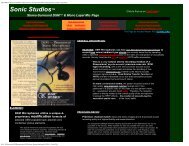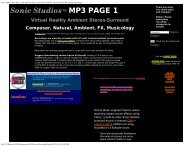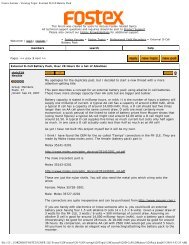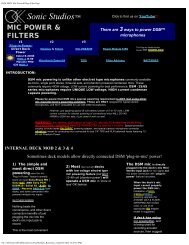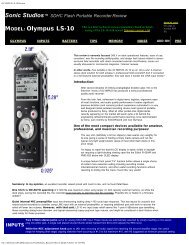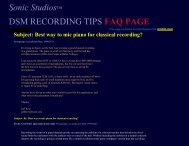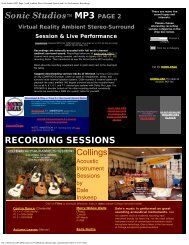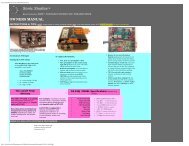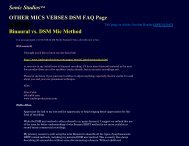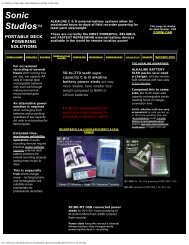Download - Sonic Studios
Download - Sonic Studios
Download - Sonic Studios
Create successful ePaper yourself
Turn your PDF publications into a flip-book with our unique Google optimized e-Paper software.
PA-6LCxx<br />
Bass Filter Series<br />
BASS Low-CUT FILTER &<br />
Mic Powering ADAPTERS<br />
See DSM Powering<br />
Page<br />
The PA-6LC, PA-6LC2, PA-6LC3, and newer PA-6LC3B power adapters power DSM microphones<br />
and provide up to 3 choices of Bass LoCut frequencies for recording sounds with excessive or<br />
unwanted low frequencies.<br />
Having a BASS LoCut filter as an option is especially valuable for recording very loud live<br />
rock-type music in concerts and small clubs that often exaggerate bass sound for a more<br />
exciting time at the show. Cranking up the bass does sound and feel great during the live<br />
performance, but makes for an extremely unbalanced 'muddy' sound when played back by<br />
even the most powerful home speaker (and headphones) systems. Recent venue trends for 50-<br />
60 cycle Mega Boom Bass requires the increased Bass control of newer PA-6LC3B with up to<br />
13 dB reduction of 60 cycle Bass-Boom. Low frequency filtering (Low Cut) is also useful for<br />
reducing recorded traffic rumble noise during street interviews<br />
Without using a LoCut during the recording of 'WAY-OVER-THE-TOP BOOMY-BASS' music venues, the home<br />
system must provide 99% of its available power to reproduce just the low frequency bass portion of the recording.<br />
This leaves very little power for the vocals, lead guitar, Hi-hat symbols, and other sounds that also need to be heard<br />
undistorted during playback.<br />
Unless you have 1-2 thousand watts and a devoted 'state-of-the-art' sub woofer (or headphones system), there is<br />
little chance of supplying the original loudness required to reproduce a gut-thumping bassy recording with the high's<br />
audible or undistorted without reduction of bass frequencies below 100 cycles during playback.<br />
A common procedure of equalization with a three-knob tone control (Bass-Mid-High) or 10-band graphic<br />
equalizer usually does the trick at the expense of increasing the phase distortion at higher frequencies.<br />
A better solution is to reduce only the exaggerated sounds below 100-200 cycles during such recordings with<br />
a simple Hi-Pass filter (a.k.a. LoCut) that leaves all other frequencies above fully intact without incurring phase or<br />
amplitude distortions.<br />
The PA-6LC3 has (3) three user selectable switch positions and can also be used after-the-fact to reduce<br />
excessive bass on already tape recorded programs when placed in-series at the analog LINE output of the playback<br />
deck.<br />
The upper curve illustrates a very<br />
bassy live show with sound that's<br />
exaggerated at low frequencies for<br />
a 'gut-thumping-feel' effect.<br />
The middle flat curve shows the<br />
effect of using the PA-6LC3 a 180 Hz<br />
setting during the recording of the<br />
same show.<br />
The lower shows just the LoCut effect or the PA-6LC3 180<br />
Hz setting if used to record on a normal bass content show.<br />
Also Available: PA-6LC* ($150)...Fixed at most popular<br />
POP-ROCK 85 cycles music setting<br />
*PA-6LC IS NOT switchable, but lower cost and most<br />
effective for Loud Very Bassy Rock<br />
PA-6LC3B (85/180/250) For Extreme 'CAR-Stereo-Type' 50-60 Cycle Single-Note-Mega-Boom-Bass control and for recording Metal Rock when<br />
extremely close to the PA speakers. Gives a much clearer recording with far less chance of deck mic input overload distortion.<br />
ADAPTERS & PATCH CORDS<br />
(See DSM Powering Page for Details)<br />
Now Record live highest quality audio on both your portable<br />
recorder & camcorder by connecting the two together.<br />
This custom designed patch cable connects to both your<br />
deck's ministereo headphones output jack and the external<br />
mic input of most camcorder models.<br />
One beneifit of using this patch is replacing low quality camera<br />
on-board mics with your choice of higher quality audio signal<br />
from an external recorder.<br />
Also, using a recorder's headphone output allows camera<br />
recording volume adjustment making it easier to avoid<br />
overloading a camera's low level mic input.<br />
The in-line jack allows headphones monitoring, or use this for<br />
patching to another recorder's audio input.



